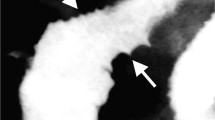Abstract
Aim of study
The objective of this study is to determine the diagnostic value of the 24-h delayed film for Hirschsprung’s disease (HD). Other features of the barium enema were also examined, in particular the correlation between the radiological transition zone (TZ) and the final pathology.
Methods
All patients with suspected HD from 2003 to 2013 who had undergone barium enema and rectal biopsy were reviewed retrospectively to study the correlation between radiological features of barium enema with the final diagnosis as well as severity.
Results
A total of 182 patients were admitted for suspected HD during the study period, of which 82 had both investigations done. 68 patients had radiological features suggestive of the disease and ultimately, 12 patients had the disease confirmed with rectal biopsy. Among those without radiological features of HD, 2 patients were found to have the disease. Thus, the sensitivity of the 24-h delayed film was 85.7 % and the specificity was 17.6 %. The positive predictive value (PPV) of this test was 20.6 % and the negative predictive value (NPV) was 85.7 %. Regarding the level of TZ, it was not detected in the barium enema in 7 (50 %) out of the 14 patients. For those with the presence of TZ, 6 (85.7 %) of them correlated well with the intra-operative findings and 4 (57.1 %) of them correlated well with the final histology.
Conclusion
The 24-h delayed film of barium enema has a high NPV and is useful to rule out HD. However, rectal biopsy is still suggested for disease confirmation given its low PPV. Lastly, once present, the level of radiological TZ is also a useful predictor for the actual disease involvement.



Similar content being viewed by others
References
Okamoto E, Ueda T (1967) Embryogenesis of intramural ganglia of the gut and its relation to Hirschsprung’s disease. J Paediatr Surg 2:437–443
O’Donnell AM, Puri P (2010) Skip segment Hirschsprung’s disease: a systematic review. Pediatr Surg Int 26(11):1065–1069
Rimoin DL, Emery AEH (2007) Emery and Rimoin’s principles and practice of medical genetics, 5th edn. Churchill Livingstone, Philadelphia
Ikeda K, Goto S (1984) Diagnosis and treatment of Hirschsprung’s disease in Japan. An analysis of 1628 patients. Ann Surg 199(4):400–405
Russell MB, Russell CA, Niebuhr E (1994) An epidemiological study of Hirschsprung’s disease and additional anomalies. Acta Paediatr 83(1):68–71
de Lorijn F et al (2006) Diagnostic tests in Hirschsprung disease: a systematic review. J Pediatr Gastroenterol Nutr 42(5):496–505
Haricharan RN, Georgeson KE (2008) Hirschsprung disease. Semin Pediatr Surg 17(4):266–275
Kuhn JP et al (2004) Caffey’s pediatric diagnostic imaging, 10th edn. Mosby, Philadelphia
O’Donovan A et al (1996) Diagnosis of Hirschsprung’s disease. Am J Roentgenol 167:517–520
Huang C et al (2011) Hirschsprung Disease and Contrast Enema: Diagnostic Value of Simplified Contrast Enema and Twenty-Four-Hour-Delayed Abdominal Radiographs. J Radiol Sci 36:159–164
Pratap A et al (2007) Application of a plain abdominal radiograph transition zone (PARTZ) in Hirschsprung’s disease. BMC Pediatr 7:5
Muller C et al (2012) Does the radiographic transition zone correlate with the level of aganglionosis on the specimen in Hirschsprung’s disease? Pediatr Surg Int 28(6):597–601
Proctor ML et al (2003) Correlation between radiographic transition zone and level of aganglionosis in Hirschsprung’s disease: implications for surgical approach. J Pediatr Surg 38(5):775–778
Rosenfield NS et al (1984) Hirschsprung disease: accuracy of the barium enema examination. Radiology 150(2):393–400
De Lorijn F et al (2005) Diagnosis of Hirschsprung’s disease: a prospective, comparative accuracy study of common tests. J Pediatr 146(6):787–792
Smith GHH, Cass D (1991) Infantile Hirschsprung’s disease—is a barium enema useful? Ped Surg Int 6:318–321
Taxman TL, Yulish BS, Rothstein FC (1986) How useful is the barium enema in the diagnosis of infantile Hirschsprung’s disease? Am J Dis Child 140(9):881–884
Esayias W et al (2013) Barium enema with reference to rectal biopsy for the diagnosis and exclusion of Hirschsprung disease. East Cent Afr J Surg 18:143–147
Author information
Authors and Affiliations
Corresponding author
Rights and permissions
About this article
Cite this article
Wong, C.W.Y., Lau, C.T., Chung, P.H.Y. et al. The value of the 24-h delayed abdominal radiograph of barium enema in the diagnosis of Hirschsprung’s disease. Pediatr Surg Int 31, 11–15 (2015). https://doi.org/10.1007/s00383-014-3632-5
Accepted:
Published:
Issue Date:
DOI: https://doi.org/10.1007/s00383-014-3632-5




